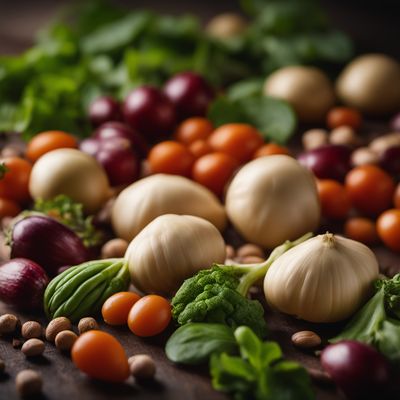
Ingredient
Legumes fresh seeds (beans, peas etc.)
Nature's Protein Powerhouse
Fresh legume seeds come in a variety of shapes, sizes, and colors, ranging from vibrant green peas to creamy white cannellini beans. They have a firm yet tender texture and a nutty, earthy flavor. Legume seeds are commonly used in soups, stews, salads, and side dishes.
Origins and history
Legume seeds have been cultivated and consumed by various civilizations for thousands of years. They have played a significant role in the diets of ancient Egyptians, Greeks, and Romans. Today, legume seeds are grown worldwide, with common varieties including black beans, chickpeas, lentils, and green peas.
Nutritional information
Fresh legume seeds are a rich source of plant-based protein, dietary fiber, complex carbohydrates, and essential vitamins and minerals. They are low in fat and cholesterol and provide a sustainable source of energy.
Allergens
May contain legume allergens.
How to select
When selecting fresh legume seeds, look for plump, firm, and brightly colored seeds. Avoid seeds that are discolored, shriveled, or have signs of mold. If purchasing in pods, choose pods that are crisp and free from blemishes.
Storage recommendations
To maintain freshness, store fresh legume seeds in a cool, dry place, away from direct sunlight. If storing in the refrigerator, place them in a breathable bag or container to prevent moisture buildup. Use them within a few days of purchase for the best flavor and texture.
How to produce
Fresh legume seeds can be easily grown in home gardens or containers. They require well-drained soil, adequate sunlight, and regular watering. Some legume seeds, such as peas, may benefit from trellises or supports for climbing.
Preparation tips
Fresh legume seeds can be prepared in various ways, including boiling, steaming, sautéing, or roasting. They can be used in soups, stews, salads, dips, spreads, and as a side dish. Soaking legume seeds overnight before cooking can help reduce cooking time and improve digestibility.
Substitutions
Canned legumes, such as chickpeas or kidney beans, can be used as substitutes for fresh legume seeds in recipes. However, the texture and flavor may vary slightly.
Culinary uses
Fresh legume seeds are commonly used in dishes such as chili, hummus, falafel, bean salads, pea soups, and curries. They are also a popular ingredient in Mexican, Mediterranean, and Indian cuisines.
Availability
Fresh legume seeds are cultivated and available in various regions worldwide, including North and South America, Europe, Asia, and Africa.
More ingredients from this category

Other Legume vegetables
The Versatile Legumes

Lentils (without pods)
Versatile Legumes

Beans (fresh seeds without pods) and similar-
The Versatile World of Fresh Beans

Lupins (without pods)
The Nutritional Powerhouse: Lupins Unleashed

Peas (without pods) and similar-
Vibrant Gems: Exploring the World of Peas
